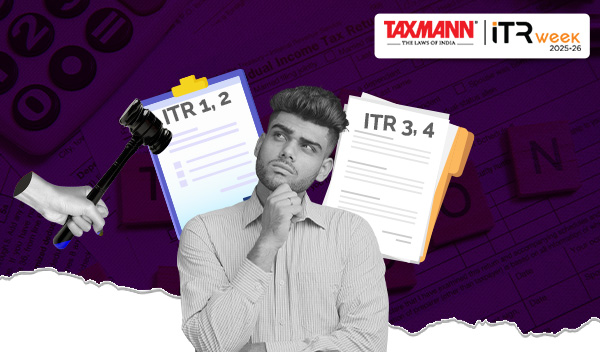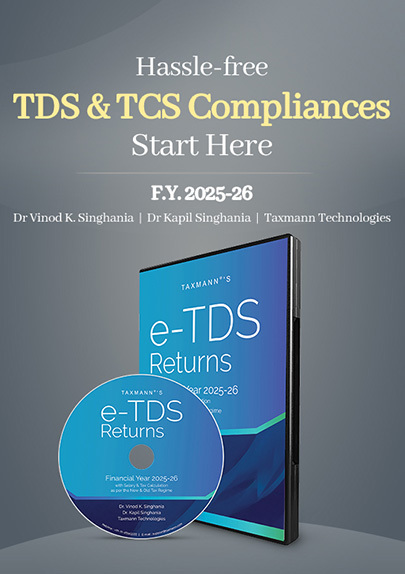Which ITR Form to File for AY 2025-26 | Complete Guide to ITR 1, 2, 3 and 4
- ITR Week 2025-26|Blog|Income Tax|
- 6 Min Read
- By Taxmann
- |
- Last Updated on 29 August, 2025

ITR Forms AY 2025-26 are the prescribed Income Tax Return forms notified by the CBDT for filing income tax returns for the financial year 2024-25 (assessment year 2025-26). These forms—ITR 1, ITR 2, ITR 3, ITR 4, and ITR 5 to 7—are designed to suit different categories of taxpayers such as salaried individuals, business owners, professionals, companies, firms, and trusts. Each form has specific eligibility based on income sources like salary, house property, capital gains, business/profession, foreign income, or presumptive taxation. The AY 2025-26 ITR forms also incorporate new changes such as revised reporting of capital gains, Aadhaar-only validation, additional disclosure requirements, and updated thresholds for assets and liabilities. This ensures that taxpayers file their returns in the correct ITR form, avoiding penalties or rejection.
FAQ 1. Which Form Should a Taxpayer Use to File His Income Tax Return for the Assessment Year 2025-26?
|
Nature of Income |
ITR 1[1] | ITR 2 | ITR 3 | ITR 4[2] |
|
Salary Income |
||||
| Income from salary/pension (for ordinarily resident person) |
✓ |
✓ | ✓ |
✓ |
| Income from salary/pension (for not ordinarily resident and non-resident person) |
✓ |
✓ |
||
| Any individual who is a director in any company |
✓ |
✓ |
|
|
| If payment of tax in respect of ESOPs allotted by an eligible start-up has been deferred |
✓ |
✓ |
||
|
Income from House Property |
||||
| Income or loss from one house property (excluding brought forward losses and losses to be carried forward) |
✓ |
✓ | ✓ |
✓ |
| Individual has brought forward loss or losses to be carried forward under the head House Property |
|
✓ |
✓ |
|
| Income or loss from more than one house property |
|
✓ |
✓ |
|
|
Income from Business or Profession |
||||
| Income from business or profession |
✓ |
|||
| Income from presumptive business or profession covered under sections 44AD, 44ADA and 44AE (for person resident in India) |
✓ |
|||
| Income from presumptive business or profession covered under sections 44AD, 44ADA and 44AE (for not ordinarily resident and non-resident person) |
✓ |
|||
| Interest, salary, bonus, commission, or share of profit received by a partner from a partnership firm |
✓ |
|||
|
Capital Gains |
||||
| Long-term capital gains taxable under Section 112A and not exceeding Rs. 1.25 lakhs |
✓ |
✓ | ✓ |
✓ |
Long-term capital gains taxable under the following provisions –
|
✓ |
✓ |
||
| Short-term capital gains taxable under any provision |
✓ |
✓ |
||
| Taxpayer has held unlisted equity shares at any time during the previous year |
|
✓ |
✓ |
|
| Capital gains/loss on sale of investments/property |
|
✓ |
✓ |
|
|
Income from Other Sources |
||||
| Family Pension (for ordinarily resident person) |
✓ |
✓ | ✓ |
✓ |
| Family Pension (for not ordinarily resident and non-resident person) |
✓ |
✓ |
||
| Income from other sources (other than income chargeable to tax at special rates, including winnings from online games, lottery, and race horses or losses under this head) |
✓ |
✓ | ✓ |
✓ |
| Income from other sources (including income chargeable to tax at special rates, including winnings from lottery and race horses or losses under this head) |
✓ |
✓ |
||
| Dividend income exceeding Rs. 10 lakhs taxable under Section 115BBDA |
|
✓ |
✓ |
|
| Unexplained income (i.e., cash credit, unexplained investment, etc.) taxable at 60% under Section 115BBE |
|
✓ | ✓ |
|
| Person claiming deduction under Section 57 from income taxable under the head’ Other Sources’ (other than deduction allowed from the family pension) |
✓ |
✓ |
||
|
Deductions |
||||
| Person claiming deduction under Section 80QQB or 80RRB in respect of royalty from patent or books |
|
✓ |
✓ |
|
| Person claiming deduction under section 10AA or Part-C of Chapter VI-A |
✓ |
|||
|
Total Income |
||||
| Agricultural income exceeding Rs. 5,000 |
✓ |
✓ |
||
| Total income exceeding Rs. 50 lakhs |
✓ |
✓ |
||
| Assessee has any brought forward losses or losses to be carried forward under any head of income |
|
✓ |
✓ |
|
|
Computation of Tax Liability |
||||
| If an individual is taxable in respect of an income but TDS in respect of such income has been deducted in the hands of any other person (i.e., clubbing of income, Portuguese Civil Code, etc.) |
|
✓ |
✓ |
|
| Claiming relief of tax under sections 90, 90A or 91 |
|
✓ |
✓ |
|
|
Others |
||||
| Assessee has –
– Income from foreign sources – Foreign Assets, including financial interest in any foreign entity – Signing authority in any account outside India |
|
✓ |
✓ |
|
| Income has to be apportioned in accordance with Section 5A |
|
✓ |
✓ |
|
| If the tax has been deducted on a cash withdrawal under Section 194N |
✓ |
✓ |
✓ |
|
| A person has deposited more than Rs. 1 crore in one or more current accounts |
✓ |
✓ |
✓ |
|
| A person has incurred more than Rs. 2 lakhs on foreign travelling |
✓ |
✓ | ✓ |
✓ |
| A person has incurred more than Rs. 1 lakh towards payment of the electricity bill |
✓ |
✓ | ✓ |
✓ |
| A person has turnover from the business exceeding Rs. 60 lakhs |
✓ |
✓ |
||
| A person has gross receipts from a profession exceeding Rs. 10 lakhs |
✓ |
✓ |
||
| Aggregate amount of TDS and TDS is Rs. 25,000 (Rs. 50,000 in case of a senior citizen) or more |
✓ |
✓ | ✓ |
✓ |
| Aggregate deposit in the savings bank account is Rs. 50 lakh or more |
✓ |
✓ | ✓ |
✓ |
|
Other Assessees |
||||
|
Status of Assessee |
ITR 4 | ITR 5 | ITR 6 |
ITR 7 |
| Firm (excluding LLPs) opting for presumptive taxation scheme of section 44AD, 44ADA or 44AE |
✓ |
|||
| Firm (including LLPs) |
✓ |
|||
| Association of Persons (AOPs) |
✓ |
|||
| Body of Individuals (BOI) |
✓ |
|||
| Local Authority |
✓ |
|||
| Artificial Juridical Person |
✓ |
|||
| Companies other than companies claiming exemption under Section 11 |
✓ |
|||
Persons, including companies, are required to furnish returns under –
|
✓ |
|||
| Business Trust |
✓ |
|||
| Investment Fund, as referred to in Section 115UB |
✓ |
|||
FAQ 2. What Changes Have Been Introduced in the ITR Forms Notified for the Assessment Year 2025-26 Compared to Last Year’s ITR Forms?
The Central Board of Direct Taxes (CBDT) typically updates the ITR forms annually to incorporate amendments made to the Income Tax Act by the preceding Finance Act. However, the ITR forms notified for the Assessment Year 2025-26 include some additional reporting requirements beyond the changes resulting from the Finance Act 2024 amendments. Some key changes introduced in the new ITR forms include:
-
- LTCG Reporting in ITR-1/4 – Long-term capital gains up to ₹25 lakh under Section 112A can now be reported in ITR-1 and ITR-4. Earlier, taxpayers had to file ITR-2 or ITR-3
- Aadhaar Requirement – Only the Aadhaar number is now accepted. Aadhaar Enrolment ID, which was allowed in AY 2024-25, is no longer valid
- Opting for New Tax Regime – Taxpayers choosing Section 115BAC must confirm continuation of the opted-out regime and furnish details of Form 10-IE/10-IEA filed in earlier years
- Presumptive Taxation for Cruise Business – A new schedule has been added in ITR-3, 5 and 6 for non-residents engaged in the cruise business under Section 44BBC
- Revised Capital Gains Tax Rates – From 23 July 2024, STCG under Section 111A is taxable at 20% and LTCG under Sections 112/112A at 12.5%. ITR forms now require date-wise reporting
- Unlisted Bonds and Debentures – Gains from transfer after 23 July 2024 are treated as short-term under Section 50AA, even if held for more than 12 months
- Disability Deduction Proof – To claim deductions under Sections 80DD and 80U, certificates other than Form 10-IA must now be furnished
- Schedule 5A Disclosure – Individuals governed by the Portuguese Civil Code must also disclose audits done under any Income Tax provision or other law, not just under Section 44AB
- Schedule AL Threshold Raised – Disclosure of assets and liabilities in ITR-2 and ITR-3 is now required if total income exceeds ₹1 crore (earlier ₹50 lakh)
- TDS Schedule Update – Deductors must now specify the section number under which TDS has been deducted
- Safe Harbour Rule Reporting – A new reporting field has been introduced in ITR-6 for companies opting for the Safe Harbour Rule in raw diamond businesses under Rule 10TIC
You can read about all the changes notified in the new ITR forms in the following article published on taxmann.com:
FAQ 3. I am a Salaried Individual and Have Earned Long-Term Capital Gains Amounting to ₹1,20,000 Taxable Under Section 112A. Which ITR Form Should I Use for Filing My Return?
Up to Assessment Year 2024-25, even if an assessee’s LTCG under Section 112A was within the exemption limit and there was no tax payable, the presence of capital gains income made them ineligible to file the simpler ITR-1 or ITR-4 forms. Instead, they were required to file the return in ITR-2 or ITR-3 forms, which are more complex and time-consuming. This resulted in a genuine hardship for small taxpayers.
To address this, the ITR forms notified for AY 2025–26 allow salaried individuals eligible to file ITR-1 and small business owners eligible for ITR-4 to continue using these forms, even if they have long-term capital gains (LTCG) provided the total LTCG does not exceed Rs. 1,25,000 which are taxable under Section 112A and there is no brought forward or carry forward capital loss.
Accordingly, a salaried individual having LTCG of Rs. 1,20,000 can choose ITR-1 to file a return of income for Assessment Year 2025-26.
[1] ITR-1 can be filed by an Individual only who is ordinarily resident in India.
[2] ITR-4 can be filed only by an Individual or HUF who is ordinarily resident in India and by a firm (other than LLP) resident in India.
Disclaimer: The content/information published on the website is only for general information of the user and shall not be construed as legal advice. While the Taxmann has exercised reasonable efforts to ensure the veracity of information/content published, Taxmann shall be under no liability in any manner whatsoever for incorrect information, if any.

Taxmann Publications has a dedicated in-house Research & Editorial Team. This team consists of a team of Chartered Accountants, Company Secretaries, and Lawyers. This team works under the guidance and supervision of editor-in-chief Mr Rakesh Bhargava.
The Research and Editorial Team is responsible for developing reliable and accurate content for the readers. The team follows the six-sigma approach to achieve the benchmark of zero error in its publications and research platforms. The team ensures that the following publication guidelines are thoroughly followed while developing the content:
- The statutory material is obtained only from the authorized and reliable sources
- All the latest developments in the judicial and legislative fields are covered
- Prepare the analytical write-ups on current, controversial, and important issues to help the readers to understand the concept and its implications
- Every content published by Taxmann is complete, accurate and lucid
- All evidence-based statements are supported with proper reference to Section, Circular No., Notification No. or citations
- The golden rules of grammar, style and consistency are thoroughly followed
- Font and size that’s easy to read and remain consistent across all imprint and digital publications are applied




 CA | CS | CMA
CA | CS | CMA
